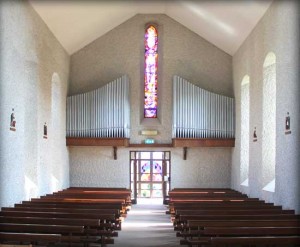Schull Parish
 This parish is the same in textent as the ancient parish of Schull with the exception of a small number of townlands. For example, the townland of Greenmount or Ardglass on the west of Ballydehob belongs to Kilcoe and Ross, though it is completely cut off from there. According to tradition, the townland was given as dowry to his daughter by the chieftain of Rossbrin on her marriage to a chieftain from Kilcoe! It appears more likely that this district was border territory in a dispute between rival chiefs in tribal times; and it is quite possible that the church authorities in Cork and Ross honoured the arrangement, however it came about.
This parish is the same in textent as the ancient parish of Schull with the exception of a small number of townlands. For example, the townland of Greenmount or Ardglass on the west of Ballydehob belongs to Kilcoe and Ross, though it is completely cut off from there. According to tradition, the townland was given as dowry to his daughter by the chieftain of Rossbrin on her marriage to a chieftain from Kilcoe! It appears more likely that this district was border territory in a dispute between rival chiefs in tribal times; and it is quite possible that the church authorities in Cork and Ross honoured the arrangement, however it came about.
In early times, this parish had two main divisions: East Schull or Kilmoe and West Schull. The name Schull is the one which has survived all the changes of history. Kilmoe is now Goleen.
The name Schull – Scoil – derives from a school founded in ancient times and dedicated to Our Lady. Smith called this school the University of Ross. Tradition tells of monks and a hermitage, but there is little historical evidence on which to rely. The townland of Ardmannagh – Ard na Manach – to the west of Schull is said to have belonged to the “Monks of Schull”. At all events, the fame of Schull as a seat of learning comes from the fanciful tale of a deputation sent from Dublin which was met at Cork by a welcoming party from Schull which spoke only in Latin. At Bandon another party awaited them, speaking only Greek, and in Clonakilty a third group addressed them in Hebrew. Fearing that the next party awaiting them in Skibbereen might be experts in Sanscrit (a language unknown to the Dubliners), the deputation withdrew!
The church of Scol is referred to in 1199; the walls of a stone church were standing in 1700, but by then, Protestants had taken over the site.
Penal Times
The determination of the people to preserve the faith is seen in the many cill sites that exist e.g. Coosheen to the east of the village and Croagh towards the sea where a cill stone was removed on several occasions for building purposes but which returned to its original place on each occasion. It was eventually thrown into the sea to prevent further desecration. Tradition also tells of a holy well at Leaca na Cille in Schull South.
Mass was celebrated in penal times in Coosheen where three upright stones indicate where the altar stood. Likewise, in the common of Mount Gabriel, Ardnamanagh at a place calle Reagh another penal altar site is still pointed out. Finally, the Report on the State of Popery of 1731 tells of “three Mass houses of thatched cabins in which Mass is celebrated”.
The Ballydehob area had its own penal sites and its own centre of learning at Bawnaknockane which is credited with being a religious house and seminary. A penal altar site is pointed out at Rossbrin in the townland of Ballycummisk where a cup-shaped depression was known as Leaca na hAltora. The protecting heights were manned by ‘lookouts’ who gave the signal when danger was near.
Post-Penal Churches
In Schull, the earliest-known of these churches was on the east of the village towards the sea where a cabin known as the Fish Palace is believed to have been the site. This church existed from about 1750 to the year 1826 when Father Thomas O’Mahony PP., erected the present Church in the townland of Meenvane. Over the years, many improvements and alterations were made in this church.
Ballydehob had its first post-penal chapel at Gurteenroe about a mile from the village and it dated from the same period as the ‘Fish Palace’ chapel. The present church was built by Father Florence O’Mahony and dedicated to St. Brigid. The date of erection is beleived to have been 1826. Thus both churches were built in advance of the granting of Catholic Emancipation in 1829.
[adapted and updated from notes by Sr. Angel Bolster] © 2007 Diocese of Cork and Ross.